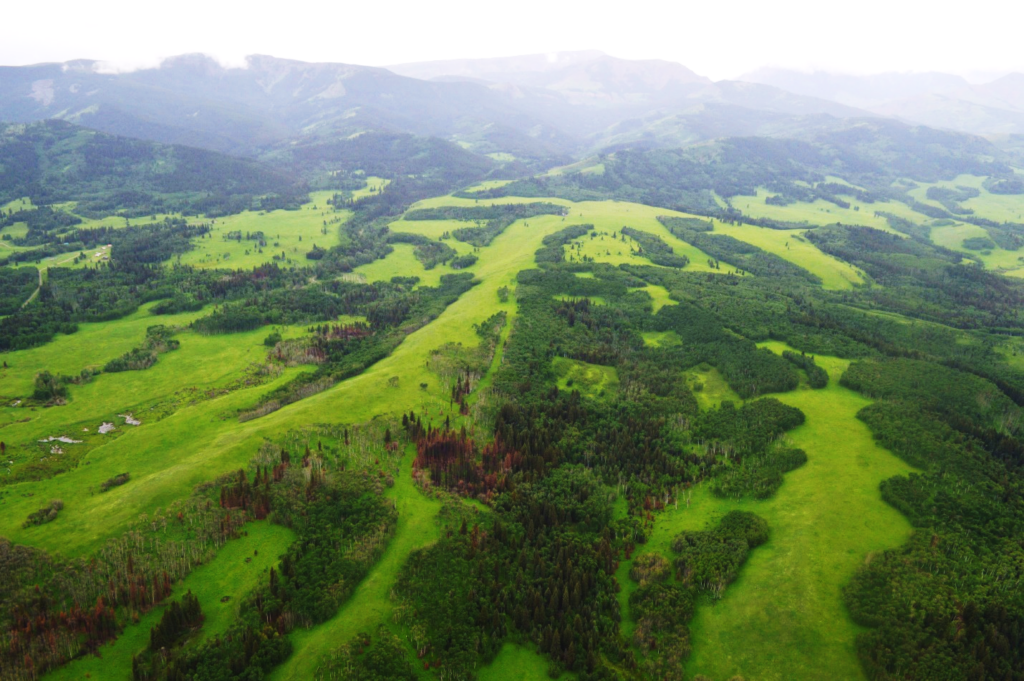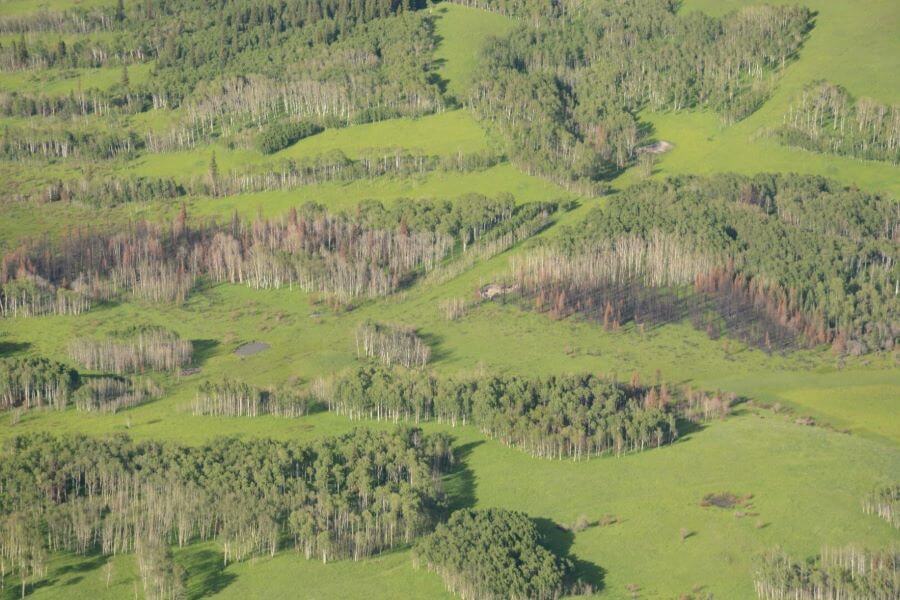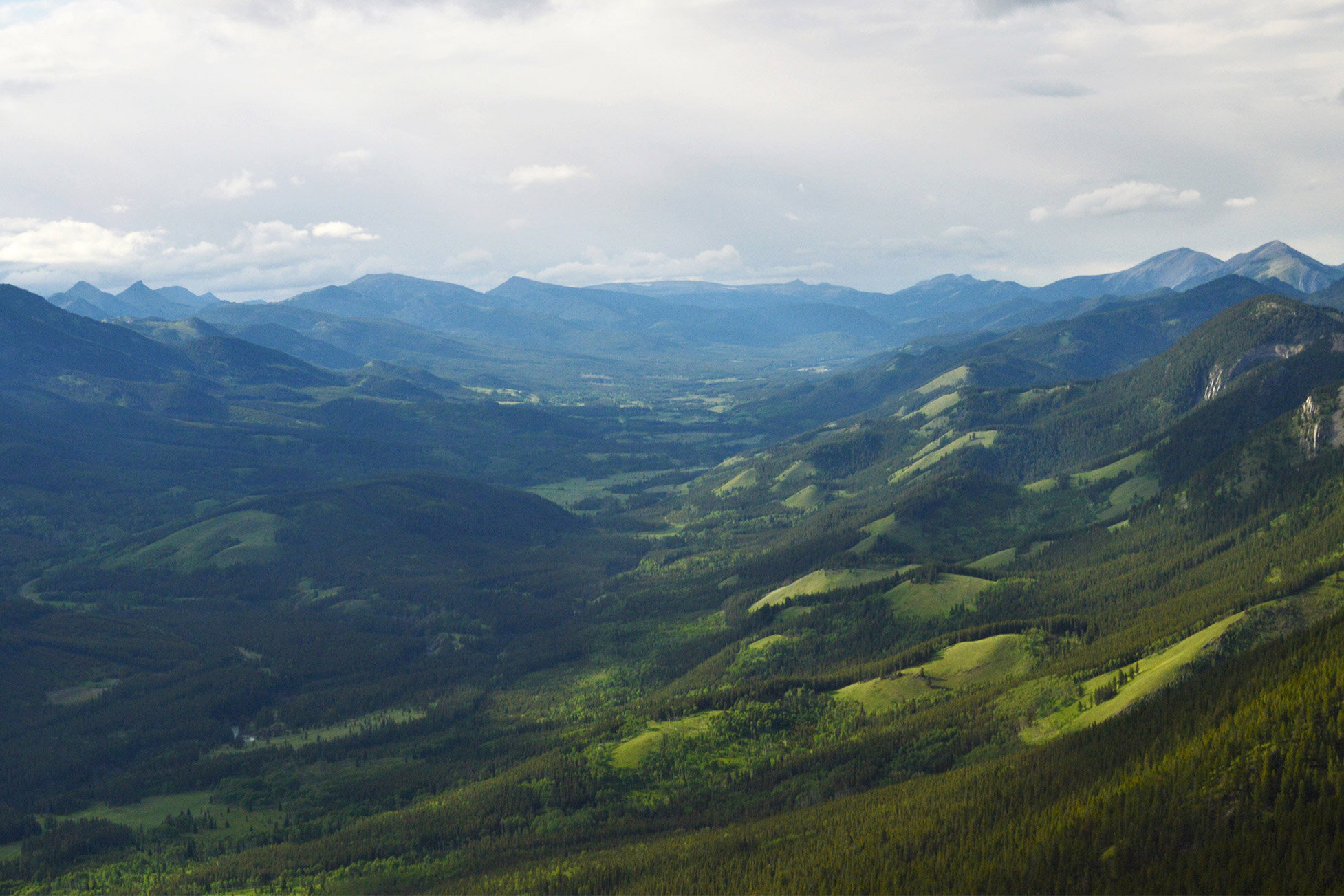By Cerros Barros
One potential consequence of mixed severity fire regimes is that some trees may survive lower intensity fires. This phenomenon is called “partial mortality”, and it can have a variety of consequences for what the landscape looks like and becomes after a fire. When trees survive, they may offer refuge for wildlife, help speed up revegetation by producing seeds, and/or help to maintain the presence of other types of vegetation like lichens. In this blog post, we discuss how the Landscapes in Motion modeling team is studying partial mortality in the Southern Foothills of Alberta using simulation models, and why this research is important for understanding the fire history of this region.
In the past, it was often thought that most fires in the Southern Foothills of Alberta were similar to those in the boreal forests in Northern Alberta: high severity burns that knocked out most of the vegetation, including most or all of the trees. However, evidence points to the historical coexistence of both low and high severity fires in locations of this region. As researchers, these findings leave us with several questions. How widespread are these mixed severity fire regimes across the diverse forests of the Foothills, how have they shaped the forests we see today, and how will they be influenced by factors like climate change in the future?
One particularly interesting characteristic of mixed severity fire regimes is that some trees may survive low and intermediate intensity fires. When some trees survive a fire, this is called “partial mortality”. This phenomenon is what provoked the LIM modeling team to ask our main research question: what happens to the landscape when some trees survive after a fire?

How to study partial mortality?
When it comes to understanding how the world works, there is no doubt that drawing up and building a model based on our current knowledge and “playing around” with it is probably only second best to direct observation. However, in many cases researchers are unable to observe their study subjects with the naked eye (e.g., events of the past, events on a molecular scale, events that take decades to occur). In these cases, modeling is an excellent way for us gain information. In fact, modeling is so important that it is used across most disciplines today, and has been for millennia[1], to help us understand how something works and even predict events under changing conditions.
Studying the phenomena and dynamics causing and following mixed severity fire regimes is no different, and models can help us immensely if they draw on our existing knowledge of how and why mixed severity fires occur and how they affect our forests. Imagine trying to study this topic in the field: you would need to burn different forest types at different levels of intensity and under different weather and topographical conditions (can you imagine how many prescribed burning experiments we would need to cover all of the different conditions out there?), and then wait for the trees and vegetation to grow back! Instead, our research team can use models to simulate this whole range of possibilities in a few minutes or hours. For the Landscapes in Motion project, modeling is a crucial learning tool.
When building a model, one of the most important first steps is to figure out what is currently known about the system you are going to model. Based on previous research, our modeling team knows that the presence of surviving trees and patches of vegetation can have an important role in determining how fast the vegetation recovers after a fire event, and can also offer places of refuge for overall biodiversity.

Surviving trees will be able to produce seeds sooner than newly germinated ones and can help repopulate burnt areas. These trees will also continue to provide habitat and shelter for many species like woodpeckers (Koivula & Schmiegelow 2007), as well as important food sources like lichen for caribou. Fires that create patchy landscapes of forests burnt at different levels may help open up the canopy, creating opportunities for morels and lichens to fruit in large numbers. These species may not establish under other conditions, as they can be overgrown by moss under very dense canopies (Winder & Keefer 2008, Silva et al. 2019).
Next steps
Using simulation models based on our current knowledge of partial mortality, our modeling team can test the consequences of assuming a predominance of high severity (or stand-replacing) fires, as opposed to assuming that fires can be of lower severity and leave surviving trees and forest patches behind. Does partial mortality change what forest types we see on the landscape, like the predominance of hardwood- and softwood-dominated forests? Are there some species or forest types that can only remain in the landscape under high severity fires, or on the other hand, are there some that require a mixed severity fire regime?
The modeling team is now asking some of these questions to our models and will soon have some answers that will help us put together more pieces of the Landscapes in Motion project puzzle. So stay tuned to find out what our models tell us about the effects of partial mortality on fire regimes in the Foothills!
Every member of our team sees the world a little bit differently, which is one of the strengths of this project. Each blog posted to the Landscapes in Motion website represents the personal experiences, perspectives, and opinions of the author(s) and not of the team, project, or Healthy Landscapes Program.
[1] Have a look a what is probably the first mechanical ‘computer’ known to us, designed by the Greeks to track and predict astronomical phenomena, the Greek Orrery or Antikythera mechanism. Very cool!
References:
Koivula, M. J., & Schmiegelow, F. K. A. (2007). Boreal woodpecker assemblages in recently burned forested landscapes in Alberta, Canada: Effects of post-fire harvesting and burn severity. Forest Ecology and Management, 242(2–3), 606–618. https://doi.org/10.1016/j.foreco.2007.01.075
Silva, J., Nielsen, S., Lamb, C., Hague, C., & Boutin, S. (2019). Modelling Lichen Abundance for Woodland Caribou in a Fire-Driven Boreal Landscape. Forests, 10(11), 962. https://doi.org/10.3390/f10110962
Winder, R. S., & Keefer, M. E. (2008). Ecology of the 2004 morel harvest in the Rocky Mountain Forest District of British Columbia. Botany, 86(10), 1152–1167. https://doi.org/10.1139/B08-045









